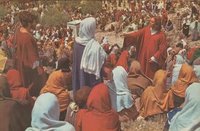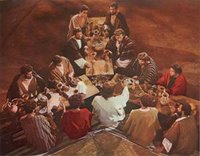King of Kings (1961)
 On paper King of Kings (1961) should have been one of the most successful Jesus films ever made. Producer Samuel Bronston and writer Philip Yordan were just months away from making the smash epic El Cid, Nicholas Ray was one of Hollywood's hottest new directors, Mikos Rozsa wrote arguably his best ever score, and Jeffrey Hunter, possibly the most aesthetic Jesus ever, lead an impressive cast. Somehow, even despite the face of Jesus finally returning to cinemas after a long exile, it all went wrong. Whilst this film still ranks amongst my favourite Jesus films, it's certainly the least defendable selection.
On paper King of Kings (1961) should have been one of the most successful Jesus films ever made. Producer Samuel Bronston and writer Philip Yordan were just months away from making the smash epic El Cid, Nicholas Ray was one of Hollywood's hottest new directors, Mikos Rozsa wrote arguably his best ever score, and Jeffrey Hunter, possibly the most aesthetic Jesus ever, lead an impressive cast. Somehow, even despite the face of Jesus finally returning to cinemas after a long exile, it all went wrong. Whilst this film still ranks amongst my favourite Jesus films, it's certainly the least defendable selection.Ironically, it is perhaps precisely because of the many big names amongst the film-makers that things went so awry with the final product. Whilst Bronston, Yordan and Ray all had good reputations, they had been earned in different fields. Bronston's ability to produce opulent epics a million miles away from Ray's more personal films such as Rebel Without a Cause (1955), and the masterful In a Lonely Place (1950).
 Furthermore, a clash between these personalities seems to have left the film in a mess. According to Nicholas Ray biographer Bernard Eisenschitz1, at the last minute Ray was told to include the Jewish rebellion action scene three-quarters of the way through the film, and an extra character called David (played by Richard Johnston), was brought in to play a similar role to the finished film's Judas. By then the film was 3½ hours long, and although Ray thought that was necessary, Margaret Booth (head of the editing department) decided to cut out "David" altogether. This resulted in one scene between Barabbas and "David" having to be re-filmed with Judas instead. As a result of these major, last minute changes, any sense of continuity was destroyed, as was the long standing friendship between Ray and Yordan.
Furthermore, a clash between these personalities seems to have left the film in a mess. According to Nicholas Ray biographer Bernard Eisenschitz1, at the last minute Ray was told to include the Jewish rebellion action scene three-quarters of the way through the film, and an extra character called David (played by Richard Johnston), was brought in to play a similar role to the finished film's Judas. By then the film was 3½ hours long, and although Ray thought that was necessary, Margaret Booth (head of the editing department) decided to cut out "David" altogether. This resulted in one scene between Barabbas and "David" having to be re-filmed with Judas instead. As a result of these major, last minute changes, any sense of continuity was destroyed, as was the long standing friendship between Ray and Yordan. To make things worse, once Ray had left the project, his final scene of Jesus leaving the disciples on a mountain was replaced by the now infamous "giant-Jesus making a cross on the beach" shot. Worse still, Jeffrey Hunter's dialogue was re-dubbed in its entirety so that he would have a lower, more serious, voice.
Given all this internal wrangling, it is hardly surprising that the film falls short of it's potential. It never really seems to know what kind of film it is. Is it a Roman action epic, or an introspective look at a rebel with a cause?2 Thankfully it is possible to peer through the rubble of the finished film to glimpse what it might have been. In fact, in places the film really soars.
 Perhaps the best scene in the film is the lengthy Sermon on the Mount scene, "Ray saw it as the linchpin of his film", and thankfully the final version of it remains strong 3. The sermon is built up from a number of different angles as Jesus' friends, his foes, and those who are simply curious to hear him gather to hear him lay out his views. After opening with the beatitudes, he moves amongst the audience to take questions, plying them with various sections from the gospels as he goes. Whilst many scholars today would questions whether such a "sermon" actually existed, Ray's attempt at demythologising it by interspersing it with the audience's questions does provide a more realistic scenario.
Perhaps the best scene in the film is the lengthy Sermon on the Mount scene, "Ray saw it as the linchpin of his film", and thankfully the final version of it remains strong 3. The sermon is built up from a number of different angles as Jesus' friends, his foes, and those who are simply curious to hear him gather to hear him lay out his views. After opening with the beatitudes, he moves amongst the audience to take questions, plying them with various sections from the gospels as he goes. Whilst many scholars today would questions whether such a "sermon" actually existed, Ray's attempt at demythologising it by interspersing it with the audience's questions does provide a more realistic scenario.Another real high point of this film is the use of colour. The action constantly takes place under an intense blue sky. There is a real vibrancy of colour in the costumes from the luxurious colours of the Romans and Herodians, to the everyday colours of the normal people that gather around Jesus. Whilst many Jesus films are concerned with Jesus's eyes, none give so many intense close shots of them as this film. I've never seen it on the big screen, but the effect of such arresting shots of his azure blue eyes shown on such a scale must have been overwhelming. Perhaps the most interesting use of colour in the film is Jesus's robes. The opening scenes before his baptism show Jesus wearing dull browns, but once his ministry begins he switches to an intense red robe - rich in connotations of authority, danger, leadership, passion, and of course of his blood that will soon be spilt. However, once he enters Jerusalem for the final phase of his ministry he switches to a white garment, emphasising his purity and presumably his innocence in all that he is about to undergo.
 The other key device that the film uses is that of a fictional Roman character, Lucius, played by Ron Randall. Lucius is first introduced as a loyal soldier who's conscience is stung when he is instructed to carry out Herod's orders to massacre Bethlehem's infants. He again happens to meet the boy Jesus in Nazareth, and finds himself encountering the adult Jesus as his popularity swells. Sent by Pilate to spy on the Sermon on the Mount he is deeply challenged and ultimately becomes the centurion exclaiming those immortal lines as Jesus dies. Lucius provides a way into the film for the viewer. Whereas the other characters have already been influenced by various connotations, Lucius is neutral, and as he, like the viewer, sees more of Jesus, he is changed by what he sees.
The other key device that the film uses is that of a fictional Roman character, Lucius, played by Ron Randall. Lucius is first introduced as a loyal soldier who's conscience is stung when he is instructed to carry out Herod's orders to massacre Bethlehem's infants. He again happens to meet the boy Jesus in Nazareth, and finds himself encountering the adult Jesus as his popularity swells. Sent by Pilate to spy on the Sermon on the Mount he is deeply challenged and ultimately becomes the centurion exclaiming those immortal lines as Jesus dies. Lucius provides a way into the film for the viewer. Whereas the other characters have already been influenced by various connotations, Lucius is neutral, and as he, like the viewer, sees more of Jesus, he is changed by what he sees.Perhaps one of the strangest things about this film is how little time Jesus actually spends on screen. Excluding credit sequences etc. Jesus is onscreen for less than half of the film's remaining run time. The rest of the film is taken up with Barabbas and the zealots' fight against Rome. This was the first major Jesus film after the discovery of the Dead Sea Scrolls, and the greater awareness they brought about the zealots and their fight. Whilst this subplot sprawls seemingly out of control, King of Kings is one of the few films to place Jesus in this kind of revolutionary saturated context. At one point Barabbas contrasts himself with Jesus, declaring, "I am fire he is water", unaware that as does so, water is shown literally overcoming the red hot swords smelted in the zealots' fire.
 These scenes do seem to gain a little too much screen time, but they are undoubtedly well executed. Whilst this detracts somewhat from the more thoughtful film about Jesus that I suspect Ray intended, it does at least make entertaining watching. And from time to time there are some memorable moments. Perhaps most significant about this film is the way it embodies its subject. Just as in the film the political machinations seem to overwhelm Jesus and lead to his downfall, so the film falls down by swamping Jesus with a depiction of that same politics and violence. Ultimately though, it is the Sermon on the Mount that has the most lasting impact.
These scenes do seem to gain a little too much screen time, but they are undoubtedly well executed. Whilst this detracts somewhat from the more thoughtful film about Jesus that I suspect Ray intended, it does at least make entertaining watching. And from time to time there are some memorable moments. Perhaps most significant about this film is the way it embodies its subject. Just as in the film the political machinations seem to overwhelm Jesus and lead to his downfall, so the film falls down by swamping Jesus with a depiction of that same politics and violence. Ultimately though, it is the Sermon on the Mount that has the most lasting impact.1 - Nicholas Ray: An American Journey, Bernard Eisenschitz, (1996), Faber and Faber
2 - It is obligatory to use this line in every discussion of this movie.
3 - Nicholas Ray: An American Journey, Bernard Eisenschitz, (1996), Faber and Faber
Labels: King of Kings














1 Comments:
At 5:21 am, March 31, 2016, Anonymous said…
Anonymous said…
I have just read your very thoughtful and incisive comment on the film.The film is among my favourites so I am biased.Your commentary on Ron Randalls character Lucius was spot on. I always thought due to the myopic criticisms of the film at the time he missed out on a supporting actor nomination. I can see your points about fragmentations especially where there are scenes of Judas which seem to have been "cut into" the action to replace something else.Love the musical score which dds to the film. Q is there a complete cut of the film including Richard Johnson's part anywhere to be found?
Post a Comment
<< Home